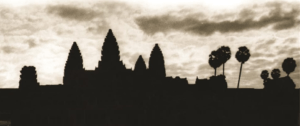Table of Contents
ToggleUnveiling the Mysteries of Angkor Wat: A Journey Through History, Spirituality, and Stone

Angkor Wat, also known as the “City/Capital of Temples,” is a Hindu-Buddhist temple complex located in Cambodia. It lies within the ancient Khmer capital city of Angkor, near Siem Reap. Angkor Wat, a name that conjures images of towering spires reaching for the heavens and intricate carvings whispering tales of a forgotten era. This magnificent temple complex is not just the world’s largest religious monument according to Guinness World Records, but a gateway to a bygone civilization, the Khmer Empire.
A Landmark Steeped in History
Built in the 12th century by King Suryavarman II, who reigned from 1113 to approximately 1150 CE, Angkor Wat served as a Hindu temple dedicated to the god Vishnu. Its construction, spanning over 30 years, is a testament to the architectural prowess and unwavering devotion of the Khmer people. As centuries passed, the temple transitioned into a Buddhist sanctuary, reflecting the evolving beliefs of the region.
Unraveling the secrets etched within Angkor Wat’s labyrinthine corridors requires understanding its rich history. The temple’s design is believed to represent Mount Meru, the mythical abode of Hindu gods. The five central towers symbolize the mountain’s peaks, while the vast moat surrounding the complex evokes the celestial ocean encircling it.

Mythology Woven in Stone
Angkor Wat’s grandeur extends beyond its physical form. The bas-relief carvings adorning the temple walls are like a visual encyclopedia of Hindu mythology. These masterpieces depict scenes from the Ramayana and Mahabharata, epic tales that continue to resonate with people across Southeast Asia.
The churning of the ocean of milk, a pivotal event in Hindu cosmology, finds its place on the eastern wall. We see gods and demons collaborating, then clashing, to obtain the elixir of immortality. The southern wall showcases the churning of the ocean of fire, another creation myth. These captivating narratives offer a glimpse into the belief systems that shaped the Khmer Empire.

Secrets Unveiled: A Deeper Look
But Angkor Wat’s mysteries go beyond the readily apparent. Researchers continue to decipher hidden messages within the temple’s layout and carvings. Some believe the complex is a giant astronomical observatory, with alignments corresponding to celestial events. Others point to astrological symbolism woven into the architectural details.
The captivating Apsara dancers, celestial nymphs carved throughout the temple, are more than just decorative elements. Their hairstyles and clothing may hold clues to Khmer court attire and social hierarchy.
The enigmatic “smiling faces” of Angkor Wat, particularly prominent in the Bayon temple within the Angkor complex, remain a topic of debate. Some interpret them as representations of Avalokitesvara, the Buddhist bodhisattva of compassion, while others see them as portraits of the Khmer king himself.
Architectural Marvels
The temple’s architecture reflects the high point of Khmer design. Key features include:
- Lotus Bud-Shaped Towers:The central tower rises 213 feet (65 meters) high, resembling a lotus bud. These towers, with their redented ogival shapes, dominate the skyline.

- Cruciform Terraces:Along the main axis of the temple, you’ll find cruciform terraces that add grandeur to the structure.
- Intricate Bas-Reliefs:The temple’s intricate carvings, known as bas-reliefs, depict scenes of daily life, battles, and celestial realms. These depict Hindu gods, ancient Khmer scenes, and stories from the Mahabharata and Ramayana.
- Symbolism of Mount Meru:The five central towers symbolize the peaks of Mount Meru, a sacred mountain in Hindu mythology. The temple’s enormous moat represents the oceans at the edge of the world, and a 617-foot (188-meter) bridge provides access to the site.
Spirituality and Mythology
- Dedication to Vishnu:Originally, Angkor Wat was dedicated to the Hindu god Vishnu. Its religious motifs and carvings reflect Hindu cosmology and mythology.
- Sunrise Magic: Witnessing the sunrise at Angkor Wat is a magical experience. As the first rays of dawn kiss the temple’s spires, they bathe the ancient stones in a golden glow. Witnessing this spectacle is a deeply spiritual experience, a moment where the past comes alive and the spirit of Angkor Wat awakens.
- Ta Prohm: Nature’s Fusion:Nearby, the Ta Prohm temple enthralls visitors. Ancient trees, their roots entwined with temple walls, create a captivating fusion of nature and architecture. You can envision yourself wandering through its labyrinthine ruins, feeling the passage of time and the whispers of ancient spirits.
- Significance of moat surrounding Angor Wat: The moat represents the cosmic ocean or the mythical “Ocean of Milk” from Hindu cosmology. In Hindu mythology, this ocean surrounds the universe and supports the world. Crossing the moat symbolized leaving the mundane world behind and entering a sacred space. The water also served as a protective barrier against negative forces. The journey across the causeway and over the moat was akin to the soul’s journey toward enlightenment.
The Legend of Angkor Wat: A Divine Construction
In the heart of Cambodia’s lush forests lies Angkor Wat, a temple complex that transcends time. According to Khmer legend, the construction of Angkor Wat was no ordinary feat—it bore the touch of the divine.
Here’s the enchanting tale:
- The Divine Mandate:
- The god Indra, ruler of the heavens, commanded the construction of a magnificent temple. He chose the site near the ancient capital of Angkor, where the Khmer empire thrived.
- Indra’s purpose was to create a celestial abode on Earth—a place where gods and mortals could commune.
- The Supernatural Builders:
- Indra summoned celestial beings, known as devas, to carry out his divine plan. These ethereal artisans descended to Earth, their radiant forms illuminating the night.
- With celestial tools in hand, they set to work, guided by the moon’s gentle glow.
- The One-Night Miracle?:
- The legend whispers that Angkor Wat materialized in a single night. The devas toiled tirelessly, their craftsmanship unmatched.
- As dawn approached, the temple stood complete—a symphony of stone, intricate carvings, and soaring towers.
- The Hidden Sun:
- Some versions of the legend claim that the sun itself dared not witness the temple’s creation. It hid behind the horizon, allowing the devas to work undisturbed.
- Only when the last stone was set did the sun emerge, bathing Angkor Wat in its golden embrace.
- The Eternal Mystery:
- Scholars now know that Angkor Wat’s construction spanned several decades, not a single night. Yet the legend persists, woven into the temple’s very fabric.
- Perhaps it reflects the devotion of those who labored, their hands guided by celestial inspiration.
So, when you stand before Angkor Wat’s lotus-bud towers, imagine the celestial dance—the gods and devas shaping stone and spirit. Their legacy endures, etched into every bas-relief and hidden alcove.
Beyond Angkor Wat: A Fusion of Nature and Architecture
Angkor Wat is just one jewel in the crown of Angkor Archaeological Park, a UNESCO World Heritage Site. Ta Prohm, another captivating temple within the complex, offers a unique experience. Here, the boundaries between nature and architecture blur beautifully. Majestic trees, their roots winding around and through the temple walls, create a scene of breathtaking harmony.
Ta Prohm, unlike the more meticulously restored Angkor Wat, allows visitors to experience the raw power of nature reclaiming its space. It’s a testament to the resilience of both the temple and the surrounding environment, a testament to the enduring cycle of life and decay.
Experiencing the Spirit of Angkor Wat
A visit to Angkor Wat is not just a historical or architectural exploration, but a cultural immersion. Witnessing local monks offering prayers in the serene courtyards fosters a sense of connection with the enduring spiritual traditions of the Khmer people.
Exploring the bustling town of Siem Reap, the gateway to Angkor, allows visitors to sample authentic Cambodian cuisine and witness traditional handicrafts being created. Engaging with local guides, their voices filled with stories passed down through generations, brings the history of Angkor Wat alive.
Their personal stories and insights illuminate the significance of the temple complex in Khmer culture, fostering a deeper appreciation for its legacy.
Insider Tips for the Aspiring Explorer
Planning a trip to Angkor Wat requires careful consideration. The best time to visit is during the dry season (November to April) to avoid heavy monsoon rains. Purchasing an Angkor Wat pass is essential for entry. Different passes offer access for one, three, or seven days, catering to your exploration timeframe. Consider purchasing your pass in advance, especially during peak season, to avoid long queues.
Respectful Exploration
Angkor Wat is a sacred site for many Cambodians. Visitors are encouraged to dress modestly, covering shoulders and knees when exploring temple grounds. Maintaining silence within prayer areas is essential to respect the ongoing religious practices.
Responsible Tourism
Sustainable tourism practices are key when visiting Angkor Wat. Opting for reputable tour companies committed to fair wages for guides and responsible waste management is crucial. Supporting local artisans by purchasing souvenirs directly from them empowers the community and preserves cultural heritage.
Beyond the Temples: Unveiling Cambodia’s Charm
Cambodia offers a wealth of experiences beyond the majestic temples. Explore the vibrant capital city of Phnom Penh, where museums and historical sites like the Royal Palace offer a glimpse into the country’s rich past. Immerse yourself in the natural beauty of Cambodia by kayaking through the Tonle Sap, Southeast Asia’s largest freshwater lake, and encountering unique wildlife.
A Journey that Endures
Angkor Wat is a place that leaves an indelible mark on the soul. It’s a testament to human creativity, devotion, and resilience, a canvas upon which stories of gods and mortals are etched in stone. It’s a place where history whispers through ancient corridors and spirituality permeates the very air.
Whether you’re a history buff, a spiritual seeker, or simply an admirer of architectural marvels, Angkor Wat awaits, ready to unveil its secrets and ignite a sense of wonder.
So, pack your bags, embrace the spirit of adventure, and embark on a journey to Angkor Wat. Let the ancient stones whisper their tales, and allow yourself to be captivated by the magic of this extraordinary place.
FAQs
- What is the best time of year to visit Angkor Wat?
The best time to visit Angkor Wat is during the dry season, from November to March, when the weather is cooler and more comfortable for exploring.
- Can I visit Angkor Wat on my own, or do I need a guide?
You can visit Angkor Wat on your own, but hiring a local guide can enhance your experience by providing deeper insights into the temple’s history and significance.
- Are there any dress code requirements for visiting Angkor Wat?
Yes, visitors are required to dress modestly, covering their shoulders and knees out of respect for the temple’s sanctity.
- How long does it take to explore Angkor Wat?
To fully appreciate Angkor Wat, plan to spend at least a full day exploring the main temple and its surrounding structures.
